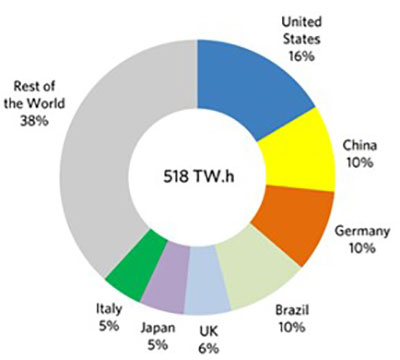The potential of biomass as an alternative fuel source
The permissible limit for producing electricity using solid fossil fuels (namely, coal) started at 800t/GWh in 2019, and then must gradually reduce to 370t/GWh by 2030. Similarly, any new electricity generation facility that produces 50 MW of electric power or more, and uses gaseous fuels (natural gas), has a permissible CO2 emission limit of 370t/GWh for 2021 and must drop to zero by 2030.1 Emissions above these limits are taxable.
This poses a financial restriction to the power sector in the production of electricity using fossil fuels unless power plants are equipped with a carbon capture and sequestration system (CCS). An alternative would be to explore renewable power options or use oxy fuel combustion. A more reliable option, however, can be to replace fossil fuels with biomass or use a mix of fossil fuel and biomass where possible.
Power producers looking for low carbon options can explore the potential of using biomass as an alternative fuel to supply relatively stable and reliable power to the grid. The federal OBPS regulations consider biomass a carbon-neutral fuel. If using both fossil fuel and biomass fuel for electricity production within one facility, the regulations offset the portion of CO2 emissions produced by burning biomass.1
Canada has over seventy biomass power plants of varying capacities with a total power output of over 2,400 MW. This is 1.7% of Canada’s total installed capacity. It can be inferred that with the new OBPS regulations provinces like Saskatchewan, with a production of around 10 million tons of grain straw every year,2 should start exploring the options of using biomass as a fuel to produce electricity while reducing their fossil fuel consumption and carbon tax exposure.
Use of biomass for electricity production is also being adopted across the globe. In 2015, the biomass share was 2% of the total production of electricity across the globe. Finland is one of the leaders in the field of biomass power and produces 6% of its total power demand using biomass. Figure 1 shows the world’s major electricity producers using biomass.3
Figure 1: Production of Electricity using Biomass across the Globe

One of the challenges for using biomass as a primary fuel for electricity production is finding a continuous, reliable supply of fuel, especially if it’s coming from a seasonal crop. A sustainable fuel supply can be managed to some extent with storage, however, the volumes required during the off-season pose significant storage costs. This can be less challenging if future biomass-fueled steam generators are equipped with burners that allow burning of an alternate biomass fuel when the prime fuel source is not available.
Another challenge is the transportation of biomass to the power plant facility. The bulk density of biomass fuels is 10% to 40% less than fossil fuels, meaning that more volume is needed to produce the same amount of thermal heat. Additionally, biomass is transported using trucks, as the fuel sources are mostly located at a distance from rail or other low-cost transportation options. Transportation costs can be minimized by locating these plants nearer biomass fuel sources. To capitalize on the benefits of biomass, it’s important to locate biomass facilities in regions with ideal sources of fuel with good transportation and grid connections.
One major advantage of biomass power plants over other renewable options such as wind and solar, is the flexibility of producing power to meet load fluctuations. Provided the fuel is reliably available, a biomass unit can be considered equally responsive to grid fluctuations as a fossil fuel power plant. This advantage may position biomass power plants as the grid supporting units during load fluctuations in the event new emissions regulations force utilities to retire fossil fuel plants.
Other benefits of biomass include:
- carbon neutrality
- potential for carbon credits (if equipped with CCS)
- flexible production
- help in minimizing fossil fuel consumption
- an additional income source for the agricultural sector
- help in waste management
In summary, biomass has immense potential as an alternative fuel source to meet both electric and thermal power requirements and avoid being taxed on excessive emissions. Recent carbon tax regulations, like OBPS for example, will trigger and uncover this potential.
References:
1. Government of Canada, "Output-Based Pricing System Regulations: SOR/2019-266", 2019, https://canadagazette.gc.ca/rp-pr/p2/2019/2019-07-10/html/sor-dors266-eng.html
2. Government of Canada, Agriculture and Agri-Food Canada, “Biomass Inventory Mapping and Analysis Tool”, 2021, https://www.agr.gc.ca/atlas/bimat
3. Canada Energy Regulator, "Canada's Adoption of Renewable Power Sources - Energy Market Analysis", 2020, https://www.cer-rec.gc.ca/en/data-analysis/energy-commodities/electricity/report/2017-canadian-adoption-renewable-power/canadas-adoption-renewable-power-sources-energy-market-analysis-biomass.html

Kamran Akhtar
, P.Eng.
Senior Engineer, Thermal Power
Kamran is a senior thermal engineer at Hatch, with over fifteen years of experience in power. He is a system design engineer, and project manager, and has experience as a technical expert for major power plant equipment manufacturers. Kamran has worked on several thermal and renewable power projects across the globe. As a thermal power professional, Kamran is always keen to help address the world’s energy needs with minimal impact to society and the environment.